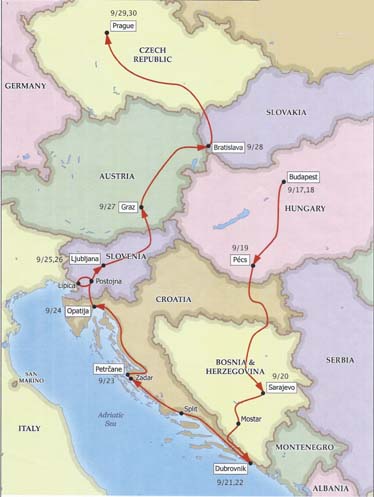
In the first century BC, a little town was built along the Danube River along the slopes of, what now is known as, Gellert Hill. Items found by archeologists suggest that the town became a trading center. Later, the area grew and became the cities of Obuda, Buda and Pest. Then in 1872, these settlements became the city we now know as Budapest, the current capital of Hungary.
Our journey began in this ancient city and then, in the following days, brought us to Pecs, Hungary; Sarajevo and Mostar in Bosnia; Dubrovnik and Petrcane in Croatia; Ljubljana in Slovenia; Graz in Austria; Bratislava in Slovakia; as well as our final destination - Prague in the Czech Republic.
Limited to 16 days, the journey did not provide the time needed to really experience the cultural habits and beliefs of the peoples in the countries we visited - as I am so used to experiencing during previous trips we did ourselves. It did offer a glimpse into the differences between them. People known as “Slavs” created kingdoms in some of the countries we visited. They came from central Asia. Their similarities lie in the fact that they all have a rich cultural heritage based on traditions that have been centuries in the making so that the term “Eastern Europe” applies more to the people and the culture than it does to specific political boundaries.
In 1985, Ramona and I visited some of this region. It was when the Soviet Union still had its influence over the area and its people. But later that decade communism collapsed in Eastern Europe. That event allowed many courageous people to begin the struggle for basic human rights and democracy. When it became apparent that the USSR no longer had the ability to put down the revolt of the people, the people began to feel more and more confident in voicing their opposition to the regimes and challenging their countries process of communist control. And, thus, Yugoslavia broke back into their former countries, some of which we visited. Czechoslovakia is now Slovakia and the Czech Republic. Now we were able to visit the countries separately and notice the differences.
30 years ago the highways we traveled in the areas we returned to were narrow, worn and treacherous. Today they are divided, smooth and double laned.
Mostar was much less commercialized 30 years ago.
Dubrovnik was the same, which is credit to those who restored that beautiful walled city after the criminally inspired war of the 1990's
In the late 90's I wrote about a bridge. Odd you might say that a bridge would be worth writing about. It was in 1985 that I first saw the bridge. It was nice but had little impact on me until a war destroyed it. In September of 2014, I was looking forward to, once again, being able to see the bridge. I wanted my new companions to see it as well. I wanted them to know the history of that remarkable bridge. It poured rain the day we arrived. Our guide became anxious and insisted we returned to our bus. Only some of us got to the bridge but were encouraged to return to our bus so we only had a glimpse. Had we waited 10 minutes longer we would have seen the rain stop and the sun shine brightly again. We were not allowed to return to the bridge. It was an enormous disappointment for me in an otherwise very successful trip. You might care to read about the bridge that I wrote about previously at Stari Most (the Old Bridge)
http://www.doughall.us/Yugoslav/Yugostar.htm
Multiple walking tours, a variety of culinary experiences, pleasant hotel experiences, a few purchases, and 16 days later, we boarded a plane in Prague, Czech Republic and returned to our families and friends.
|